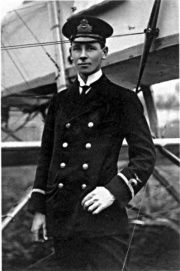Reginald Alexander John Warneford


Reginald Alexander John Warneford, VC (15 October 1891 – 17 June 1915) was a Royal Naval Air Service (RNAS) officer who was awarded the Victoria Cross.
Warneford was born at Darjeeling, India, the son of an engineer on the Indian Railways. He was brought to England as a small boy and educated at King Edward VI School, Stratford-upon-Avon but when his family returned to India he continued his education at the English College, Simla.
Following apprenticeship in the merchant marine, Warneford joined the British-India Steam Navigation Company. At the time of the outbreak of World War I, he was in Canada awaiting return to India. Instead, he sailed then to Great Britain, joining the Army but almost straightaway transferred to the Royal Navy Air Service for pilot training.
Warneford's initial training took place at Hendon Aerodrome, passing then to Central Flying School, Upavon where he completed his pilot training on 25 February 1915. During the course of training, the Commander of Naval Air Stations, R. M. Groves was quoted as saying: "This youngster will either do big things or kill himself.". Warneford's flying instructor at the time, Warren Merriam, noted his skills as a pilot but had to make special arrangements to ensure that Warneford's perceived over-confidence did not bar him from attaining a commission. Merriam took an opportunity whilst Commander Groves was visiting Hendon to ask Warneford to demonstrate his flying skills. Groves' favourable impression overcame the views of the Squadron Commander at the time who believed that Warneford would never make an officer because of his lack of concern for disciplinarian matters.
Warneford was initially posted to 2 Wing on the Isle of Sheppey in Kent but was quickly (7 May 1915) posted to an operational unit with 1 Wing at Veurne on the Belgian coast. Over the next few weeks, Warneford was involved in attacks on German troops and guns, as well as actions against enemy aircraft. His aggressiveness and effectiveness led to his being given his own aircraft and a roving commission.
On 17 May 1915, Warneford encountered Zeppelin Airship LZ39 setting out on a raid over Britain. He attacked LZ39 with machine gun fire but the airship was able to ascend out of range by jettisoning ballast.
Warneford was 23 years old, and a Flight Sub-Lieutenant in the Royal Navy's 1 Squadron, RNAS when the following action took place for which he was awarded the VC. On 7 June 1915 at Ghent, Belgium, Warneford, flying a Morane-Saulnier Type L, attacked and completely destroyed the German airship LZ37 in mid air. He had chased the airship from the coast near Ostend and, despite its defensive machine-gun fire, succeeded in dropping his bombs on it, the last of which set the airship on fire. The explosion overturned the attacking plane and stopped its engine. Having no alternative, Warneford had to land in hostile country, but after 35 minutes spent on repairs, he managed to restart the engine and returned to base.
On 17 June 1915, Warneford received the award of Légion d'honneur from the French Army Commander in Chief, General Joffre. Following a celebratory lunch, Warneford travelled to the aerodrome at Buc in order to ferry an aircraft for delivery to the RNAS at Veurne. Having made one short test flight, he then flew a second flight, carrying an American journalist, Henry Beach Newman, as passenger. During a climb to 200 feet, the right wings collapsed leading to a catastrophic failure of the airframe. Accounts suggest that neither occupant was harnessed and were thrown out of the aircraft, suffering fatal injuries. In the case of Newman, death was instantaneous. Warneford died of his injuries on the way to hospital.
He was buried at Brompton Cemetery, London on 21 June 1915 in a ceremony attended by thousands of mourners.
His Victoria Cross is displayed at the Fleet Air Arm Museum.
See Also
Sources of Information
- [1] Wikipedia


